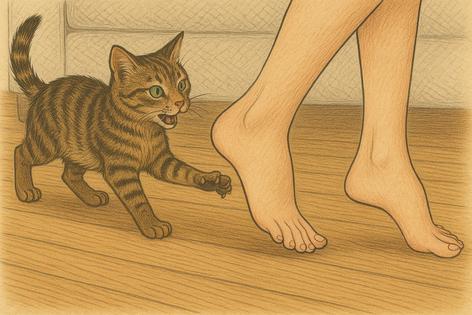Why does my cat keep attacking my feet?
Published in Cats & Dogs News
If you’ve ever walked barefoot across your living room only to be ambushed by a furry little missile with claws, you’re not alone. Countless cat owners have found themselves the target of ankle assaults, toe nibbles, or sneak attacks from under furniture. While the behavior may seem cute—or at least tolerable—when your kitten is small, it can grow into a frustrating and painful problem. Fortunately, you’re not powerless. With some insight into why cats attack feet and practical techniques for redirecting this behavior, you can reclaim your toes and restore peace in your home.
Cats rarely act out without reason. One of the most common causes of foot attacks is rooted in your cat’s natural predatory instincts. Cats are hunters by design, and to a feline brain, a wiggling foot under a blanket or an ankle rounding a corner looks remarkably like prey. A foot is the right size, moves unpredictably, and—most importantly—seems just chaseable enough to be fun. This instinct is especially strong in younger cats, or cats who haven’t had enough playtime or enrichment. The lack of stimulation can leave them with an excess of energy and a need to burn it off any way they can. Your foot just happens to be handy.
Boredom is another major factor. Even older cats, if left alone with no toys, window perches, or interaction, may become desperate for any kind of stimulation. A twitching foot may be the most exciting thing they’ve seen all day. They pounce, not because they’re mean, but because they’ve got nothing better to do. Similarly, some cats attack feet as a form of attention-seeking. If they've learned that foot attacks result in you stopping, squealing, reacting, or playing with them—even negatively—they may continue the behavior because it works. To them, any response is better than none.
Kittens that were separated from their littermates too early may not have learned appropriate boundaries. In a litter, kittens roughhouse constantly, and when one bites too hard, the other yelps and stops playing. This feedback loop teaches bite inhibition and social restraint. A kitten raised in isolation or removed too soon doesn’t always get that lesson and may treat your feet the same way they treated their sibling’s tail—with zero concept that it might hurt you.
In some cases, sudden foot attacks can be a sign of stress or overstimulation. Cats who are overwhelmed by noise, new smells, changes in the household, or a recent move may lash out physically because they have no other outlet for their discomfort. These attacks often seem to come out of nowhere and may be misinterpreted as aggression, when in fact they are a form of nervous energy release or redirected frustration.
Stopping the behavior starts with redirecting the impulse in healthier ways. The most effective way to prevent foot attacks is to increase playtime. Set aside at least two daily sessions of interactive play, using toys that mimic prey—like feather wands, dangling strings, or motorized toys that skitter across the floor. The goal is to let your cat indulge its hunting instincts in a productive, structured environment. Let them chase, pounce, and finally “catch” the toy. If you end the session with a treat or small meal, you’re completing the hunt-catch-eat cycle that satisfies their evolutionary needs.
Consistency is key. Don’t reward the foot attacks with any kind of reaction that might be interpreted as fun. That means no laughing, yelling, or chasing them away. If your cat lunges at your foot, stop moving, freeze entirely, and quietly ignore them. Most cats lose interest if their prey suddenly stops being fun. If the behavior persists, consider walking with a toy in hand and tossing it ahead of you as a distraction when you notice their body language gearing up for a pounce. You can also keep your cat confined to a different room during your most vulnerable times—like getting out of bed in the morning or walking to the kitchen in slippers—until they’ve calmed down.
Providing enrichment throughout the day can make a big difference. Window perches for birdwatching, puzzle feeders that challenge them to “hunt” for kibble, cat trees to climb, and a variety of toys to rotate through will help prevent boredom-driven mischief. If your cat always seems to go for your feet around the same time each day, try to schedule a play session right before that time. Preemptive play can prevent frustration from building up in the first place.
If your cat is particularly persistent, you may want to introduce gentle deterrents. Double-sided tape on your ankles or socks, a citrus-scented leg lotion (many cats dislike citrus), or even just jingling a keychain when they crouch to pounce can break the habit without causing harm or fear. However, never use physical punishment, water spraying, or yelling—these can break trust and often make the behavior worse in the long run.
In rare cases, foot aggression may be a symptom of a medical issue. If your cat’s attacks come on suddenly, seem unusually intense, or are accompanied by other changes in behavior like hiding, litter box issues, or excessive grooming, consult a veterinarian. Pain or neurological conditions can sometimes manifest as uncharacteristic aggression.
Finally, patience matters. Cats don’t change overnight, and habits take time to unlearn. But with understanding, consistency, and a bit of creative redirection, you can help your cat channel their inner predator somewhere more appropriate—and let your feet walk in peace once again.
========
This article was created, in part, utilizing AI tools.









Comments